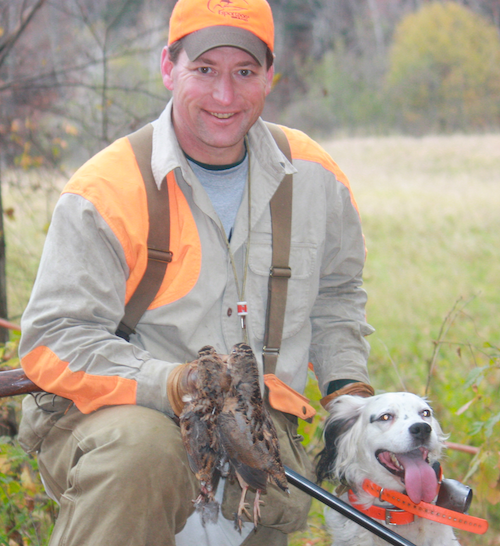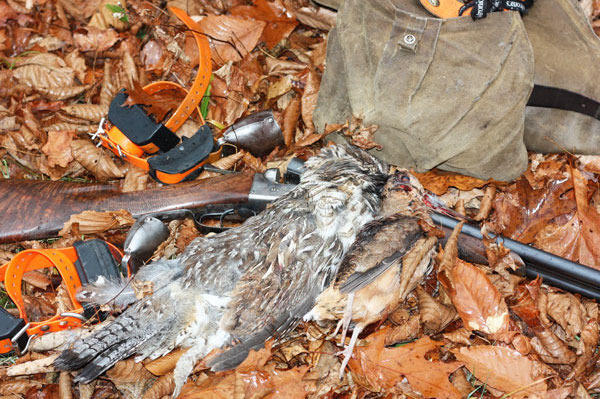One afternoon, a shotgun in particular caught my eye: a two-barrel set Parker VH. A California man owned it, and I couldn’t understand why he’d let it go. The 20-gauge barrels were 26-inches long, choked modified, and full. The 28-gauge barrels were 28-inches long and choked the same. The seller offered the gun at a price so staggeringly cheap that even I could afford it.
The gun was buried deep in the listing sheet, so the posting must have been old. I was baffled: Why didn’t this little slice of heaven get snagged up its first day on the site? This classic American side-by-side would be perfect for hunting grouse, quail, and woodcock. I couldn’t have thought of a better configuration, and I contacted the owner for more pictures.
I didn’t need to enlarge the images he emailed back to be horrified: Three drywall screws (two rusted, one missing its head) held together the stock. The toe of the butt was chipped. The dog’s head buttplate was shattered. The receiver screws were chewed up and out of the traditional Parker alignment. Each set of barrels was rubbed silver. No case colors remained on the receiver. This Parker was beyond rough.
Despite obvious flaws, something about the gun made me call the owner. During our conversation, he reported that there was neither dings in the barrels nor pitting in the bores. In addition, he said the hinge pin plate held tight and didn’t wiggle, and to my surprise, the top lever sat in the appropriate, slightly off-center position.
The man asked if I wanted to see more pictures.
“That’s not necessary,” I said, believing doing so would feel like revisiting a crime scene. “Do you accept credit cards for the three-day inspection?”
Silence on the line.
“You’re really interested in the gun?” he asked after a moment.
“Well, the gauges and barrels would be good for hunting grouse, quail, and woodcock. Plus, I was born in Meriden, and I have an affinity for Connecticut River Valley firearms.”
The guys from my local gun shop called me a few days later to announce the gun’s arrival. After work, I showed up to fetch my purchase and found a crowd had gathered. Evidently, the people wanted to see the idiot who would buy a gun in such condition. At the counter, I overheard a few sniggers as I quietly filled out the paperwork and packed up the Parker. One guy mumbled, “He’ll ship it back when he comes to his senses.”
The three-day inspection period ended unceremoniously.
George Bird Evans once said, “The man who goes out with a gun without tradition is as impoverished as the man who goes out without a dog.” With those words in mind, I set about restoring the silver mess. I wanted a straight English stock, the barrel brown on both sets, and new case coloring on the receiver. I needed to open the 20 guage’s right-barrel choke to .000 and the left to .004. I’d leave the 28-gauge chokes alone.
To do this, I sent the gun to Larry Del Grego III, a Parker specialist whose grandfather worked at the Parker factory in the town where I was born. When Remington acquired the company and moved the plant to Ilion, New York, Larry’s granddad went along for the ride and became an expert on the guns. He passed down the tradition of working with the fabled Parkers, and today few people know the shotguns better than Larry.
And what he did with the gun and returned to me is truly remarkable.
A gun this nice doesn’t deserve to sit in a cabinet. It demands to be used. And so I do just that. Nowadays, the case colors have begun fading, and my hands have sweated away some of the stock’s brown. Given enough time, the barrels will silver. But the Parker will always carry fond memories—those of Rebel pointing his first woodcock or Albert his first grouse. Or of an honored point by Ocracoke and Rowdy on a covey of North Carolina quail. Rust will speck the receiver from the time we hunted all day in a downpour because the flights were on. Dings will pepper the stock from crossing stonewalls at the end of long, good days afield.
I’m just this Parker’s temporary owner, one who has added a few points and birds to its history. And come to think of it, the next owner, whom I hope comes many years from now, will probably want to spruce up the gun a bit, too.
 Tom Keer is an award-winning writer, columnist, and blogger who lives in Cape Cod, Massachusetts. He writes regularly for more than a dozen outdoor magazines and owns The Keer Group, a full-service, outdoor marketing company. When not fishing, Keer and his family bird hunt over their four English setters. Visit him at www.thekeergroup.com or at www.tomkeer.com.
Tom Keer is an award-winning writer, columnist, and blogger who lives in Cape Cod, Massachusetts. He writes regularly for more than a dozen outdoor magazines and owns The Keer Group, a full-service, outdoor marketing company. When not fishing, Keer and his family bird hunt over their four English setters. Visit him at www.thekeergroup.com or at www.tomkeer.com.

